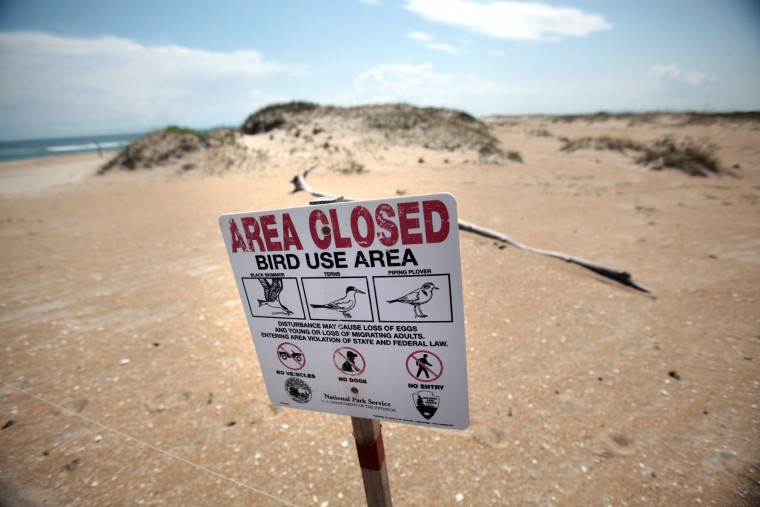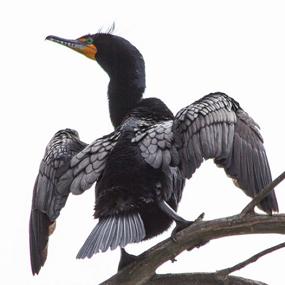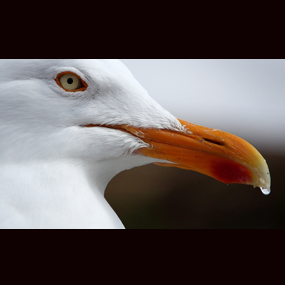For “Winged Wednesday”:
New Study Finds Pesticides Leading Cause of Grassland Bird Declines
Horned Lark and chicks by Middleton Evans
(Washington, D.C., February 25, 2013) “A new study led by a preeminent Canadian toxicologist identifies acutely toxic pesticides as the most likely leading cause of the widespread decline in grassland bird numbers in the United States, a finding that challenges the widely-held assumption that loss of habitat is the primary cause of those population declines.
The study looked at five potential causes of grassland bird declines besides lethal pesticide risk: change in cropped pasture such as hay or alfalfa production, farming intensity or the proportion of agricultural land that is actively cropped, herbicide use, overall insecticide use, and change in permanent pasture and rangeland.” More at: http://www.abcbirds.org/newsandreports/releases/130225.html
______
Domestic Cats and Billions of Birds
“The old adage about taking the cat out of the wild, but not the wild out of the cat now has a number associated with it. That number is 2.4 billion.



Most everyone would agree that keeping house cats (estimated to be some 29 percent of the kills -- say "only" some 700 million birds worth) in the house and confronting the bigger problem of feral cats is needed. If you love cats and care about nature, there are billions of reasons to keep your cats out of the wild.” More at: http://www.huffingtonpost.com/steve-zack/domestics-cats-and-billio_b_2701892.html
______
Top Reasons to Keep Cats Indoors
“For those holdouts for letting cats roam free, consider these top reasons to keep cats indoors.” Article at: http://cats.about.com/od/indoorsvsoutdoors/tp/keepindoors.htm
______
Rodent shortage driving Canadian owls into Wisconsin
A great gray owl perches on a sign near the Capital Brewery in Middleton.
“A crash in rodent populations in Canada pushed three species of owls into Wisconsin over the winter. The species are the northern hawk, the great gray and boreal owls. They are normally quite rare in Wisconsin. But a drop in rodent numbers in the boreal forest of Canada has sent the birds into Wisconsin.
The downside: The long winter and unfamiliar landscapes have taken a toll on the owls. There have been reports of great gray and northern hawk owls being killed in vehicle collisions, especially in northern Wisconsin. They tend to hunt in roadside ditches. Boreal owls are being seen near bird feeders, where they look for mice attracted to the feeders.
The DNR says it wants to know more about the sightings - regardless of whether the owls are dead or alive. It's asking people who see the birds to fill out a rare bird sighting form at the Wisconsin Society for Ornithology's website.” More at: http://www.jsonline.com/news/wisconsin/rodent-shortage-driving-canadian-owls-into-wisconsin-b99b72e-200338081.html
______
Owl rescued in N.D. heading to University of Minnesota for recovery
A great horned owl dangles from a kite string in a tree in Lincoln Park in Grand Forks, N.D. Bird experts, police officers and firefighters rescued the raptor. / Eric Hylden/The Grand Forks Herald/AP
“The Grand Forks Herald reports that skiers spotted the female owl hanging by a thread 20 feet off the ground on Wednesday.
Several local raptor experts came to her rescue. Tim Driscoll led the effort to save the nearly 4 pound raptor. He says the owl is doing well. One of Driscoll’s former students, Cayla Bendel, is taking the owl to the Raptor Center at the University of Minnesota in St. Paul so it can get X-rays and wraps for its wings.”
_______
Anglers, drivers give way to birds on Hatteras beach
“Piping plovers will begin mating rituals soon on Cape Hatteras National Seashore - an area where sport fishing and beach driving are popular.

A precipitous drop in piping plover nests in the late 1990s and early 2000s prompted environmental groups to sue the National Park Service, which oversees the park. Piping plovers are a threatened species.
While breeding pairs were up last year to 15, the baby-bird survival rates were not. Of the 71 eggs laid, only 11 young survived to leave the nests.” More at: http://hamptonroads.com/2013/03/anglers-drivers-give-way-birds-hatteras-beach
_______

BirdNote Weekly Preview: What's a "Timberdoodle?"
Upcoming Shows:

SUNDAY Music Inspired By Chicks Hatching featuring music by Mussorgsky & Ravel LISTEN NOW ►
What's That? MONDAY The Delirian - Believe it or Not by Frank Corrado LISTEN NOW ►
Double-crested Cormorant TUESDAY Double-crested Cormorant by Frances Wood LISTEN NOW ►
Steve Osmek with the coyote airboat WEDNESDAY Airport Wildlife Management by Todd Peterson LISTEN NOW ►
American Woodcock THURSDAY American Woodcock –Timberdoodle by Bob Sundstrom LISTEN NOW ►
Rock Pigeon FRIDAY Pigeon Babies Do Exist by Frances Wood LISTEN NOW ►
Western Gull SATURDAY Seabirds Drink Salt Water by Dennis Paulson LISTEN NOW ►
______
Some other winged friends, the bees:
Campaign to Save Earth's Honeybees!
“It's long been known that Earth's honeybee population is decreasing at an alarming rate. The fact is, much of our natural ecosystem depends on the processes involved with bee pollination, and if this pollination cannot happen, many of our crops — from broccoli to strawberries — will be in grave peril.
![SaveEarthsHoneybees_250x250[1] SaveEarthsHoneybees_250x250[1]](https://blogger.googleusercontent.com/img/b/R29vZ2xl/AVvXsEghRQ7-WyAg0kQb1Pv3M1NY8b7WjjRQUHN3Ibr5zDj91w1VSRCJ-cT4lBZlDrTsWaiSWflmpJgO3PEkRbeApOs5WaCay_SVsGkUhnYWiKsoNjzeBkdhunAEz8d7ArIKAkeZkqdKt3g9j0xX/?imgmax=800)
We can afford insects eating our plant life; but we simply cannot afford a decimation of the honeybee.”
Take Action: Urge the EPA to outlaw nicotine-based pesticides that are killing off honeybees here: http://therainforestsite.greatergood.com/clickToGive/trs/petition/SaveEarthsHoneybees
-------
Buzz On!! Tips for Making Bees Feel Welcome

Native bees are typically hairier than honeybees, making them better at capturing and distributing pollen. Medford Taylor/National Geographic Stock
“Bee-autify your backyard!
Set the world abloom. Bees depend on pollen and nectar for food, so it’s essential to have flowers blooming successively in spring, summer, and—for late-season species such as bumblebees—even fall. When architectural designer Denise Shreeve decided to help native pollinators on her McLean, Va., property, the first thing she did was plant native vegetation that would attract them and wouldn’t need chemicals to thrive. For early-season pollinators such as the orchard mason bee, Shreeve has willows, dogwoods, and eastern redbuds. She also resists the urge to pull dandelions: “Even though they aren’t native, they are an early source of pollen,” she says.
Variety is bee-autiful
To keep your bees flying straight, plant a variety of fruits, vegetables, herbs, shrubs, trees, and wildflowers like wild mint, sunflower, and thistle (check xerces.org or contact your local university extension service for help identifying native types). “They all provide different mixes of nutrients, minerals, fats, and proteins in their pollen,” says Vaughan. Another reason for variety: All bees have different size tongues, says Shreeve, and they need different size flowers to access the nectar and pollen.” More at: http://www.humanesociety.org/news/magazines/2013/03-04/welcome-native-bees-to-your-backyard.html
______
On This Day:
Jesse James is murdered, Apr 3, 1882:
“One of America's most famous criminals, Jesse James, is shot to death by fellow gang member Bob Ford, who betrayed James for reward money. For 16 years, Jesse and his brother, Frank, committed robberies and murders throughout the Midwest. Detective magazines and pulp novels glamorized the James gang, turning them into mythical Robin Hoods who were driven to crime by unethical landowners and bankers. In reality, Jesse James was a ruthless killer who stole only for himself.
In 1873, the James gang got into the train robbery game. During one such robbery, the gang declined to take any money or valuables from southerners. The train robberies brought out the Pinkerton Detective Agency, employed to bring the James gang to justice. However, the Pinkerton operatives' botched attempt to kill James left a woman and her child injured and elicited public sympathy for Jesse and Frank James.
The James gang suffered a setback in 1876 when they raided the town of Northfield, Minnesota. The Younger brothers, cousins of the James brothers, were shot and wounded during the brazen midday robbery. After running off in a different direction from Jesse and Frank, the Younger brothers were captured by a large posse and later sentenced to life in prison. Jesse and Frank, the only members of the gang to escape successfully, headed to Tennessee to hide out.
After spending a few quiet years farming, Jesse organized a new gang. Charlie and Robert Ford were on the fringe of the new gang, but they disliked Jesse intensely and decided to kill him for the reward money. On April 3, while Jesse's mother made breakfast, the new gang met to hear Jesse's plan for the next robbery. When Jesse turned his back to adjust a picture on the wall, Bob Ford shot him several times in the back.
His tombstone reads, "Jesse W. James, Died April 3, 1882, Aged 34 years, 6 months, 28 days, Murdered by a traitor and a coward whose name is not worthy to appear here."
______
Yesterday:
Misty and I had our walk down there when we went to get Jay. He wanted to get out of the subdivision and go with me for the 50 mile round trip to the vet for Terry’s second penicillin shot. The sky was overcast, and so I knew that even with the cat with us, we could make a few stops and get some items off my shopping list.
This time, I used a larger carrier for Terry, and placed a small litter box in there, so he wouldn’t get “took short”, even though he hasn’t been eating or drinking. Every time I feed him with the feeding syringe, he just spits it out. Having tried to tempt him to eat by himself with all kinds of food, including tuna, I am at my wit’s end. I know that fish, soy and ‘by-products’ are bad for cats, and can lead to hyperthyroidism, http://www.wvcats.com/hyperthyroidism.html , among other ailments, so I avoid those, and the cans with the white lining. But years of bad feeding by his previous caregiver might have lead to his ill health.
On the way to the vet, Jay and I stopped at Walmart to get a metal detector, as I am still trying to find my survey stakes, but we had to get one from Academy. When we arrived at the vet, I tried to feed Terry again with the food I had packed in a little ice bag. Still no go, he just doesn’t want to eat.
On the way back, we stopped at the Dollar Tree, as that is where they have the stronger reading glasses, and it’s always good to have spares. A few things at Krogers, Petsmart and then home, but we were still gone for about 4 hours. Terry travels well, and sits quietly looking through his carrier door as the scenery goes by. He should be a good RVing cat, if he ever gets well.
There were severe storms in the surrounding counties during the night, but nothing bad here. This morning I received a recorded phone call from the power company saying that they were sorry for the inconvenience and that my power should now be restored. We didn’t lose power, but obviously some people did.
Today’s trip to the vet might include some thrift shopping, as it will be another overcast day.






















2 comments:
What did the Vet say was wrong?
Hi DD,
All they say is that it is Feline Upper Respiratory Infection.
But from all I have read, he should be better by now. It's now Sunday, and still can't get him to eat.
Happy Tails. Penny
Post a Comment